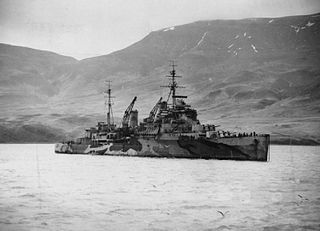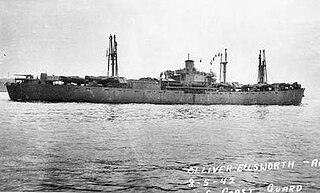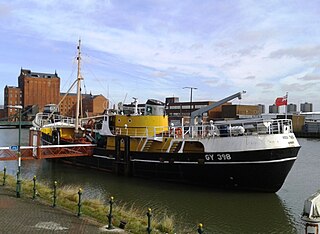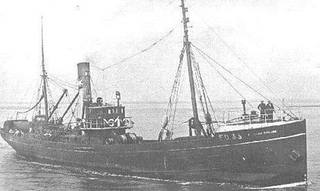Related Research Articles

German submarine U-552 was a Type VIIC U-boat built for Nazi Germany's Kriegsmarine for service during World War II. She was laid down on 1 December 1939 at Blohm & Voss in Hamburg as yard number 528, launched on 14 September 1940, and went into service on 4 December 1940. U-552 was nicknamed the Roter Teufel after her mascot of a grinning devil, which was painted on the conning tower. She was one of the more successful of her class, operating for over three years of continual service and sinking or damaging 35 Allied ships with 164,276 GRT and 1,190 tons sunk and 26,910 GRT damaged. She was a member of 21 wolf packs.
The Cod Wars were a series of 20th-century confrontations between the United Kingdom and Iceland about fishing rights in the North Atlantic. Each of the disputes ended with an Icelandic victory.

The Arctic Corsair(H320) is a deep-sea trawler, built in 1960, that was converted to a museum ship in 1999. She is temporarily berthed at Alexandra Dock in Kingston upon Hull, England, pending completion of a new permanent location in the city's Museums Quarter. Exhibits and guides aboard the boat tell the story of Hull's deep-sea fishing industry.

ICGV Óðinn is a decommissioned offshore patrol vessel formerly operated by the Icelandic Coast Guard. She is the oldest ship in the coastguard's fleet, and it is believed that her Burmeister & Wain engines are the only such engines that are still serviceable in the world today. Since her withdrawal from active duty, she has served as a floating exhibit at the Reykjavík Maritime Museum in Reykjavík Harbour. The ship is still maintained, and operative as of June 2022.

German submarine U-38 was a Type IXA U-boat of Nazi Germany's Kriegsmarine that operated during World War II.

PQ 13 was a British Arctic convoy that delivered war supplies from the Western Allies to the USSR during World War II. The convoy was subject to attack by German air, U-boat and surface forces and suffered the loss of five ships, plus one escort vessel. Fifteen ships arrived safely.

SS Oliver Ellsworth was a Liberty ship built in the United States during World War II. She was named after Founding Father Oliver Ellsworth, an American lawyer, judge, politician, and diplomat. He was a framer of the United States Constitution, a United States senator from Connecticut, and the third Chief Justice of the United States.

HNoMS Honningsvåg was a naval trawler that served throughout the Second World War as a patrol boat in the Royal Norwegian Navy. She was launched at the North Sea harbour of Wesermünde in Hanover, Germany in February 1940 as the fishing trawler Malangen and was captured by Norwegian militiamen at the North Norwegian port of Honningsvåg during her maiden fishing journey to the Barents Sea. Having taken part in the defence of Norway in 1940 she spent the rest of the war years patrolling the ocean off Iceland. She was decommissioned in 1946, sold to a civilian fishing company in 1947 and scrapped in 1973.
The Hull triple trawler tragedy was the sinking of three trawlers from the British fishing port of Kingston upon Hull during January and February 1968. A total of 58 crew members died, with just one survivor. The three sinkings brought widespread national publicity to the conditions in which fishermen worked, and triggered an official inquiry which led to major changes to employment and working practices within the British fishing industry.

The Viola is a steam trawler built in 1906 in Hull. She is the oldest surviving steam trawler in the world. During her long career, she was known as HMTViola, Kapduen, and Dias. She is currently beached at Grytviken in South Georgia, though there are currently plans afoot to return her to Hull.

SS West Eldara was a steel-hulled cargo ship built in 1918 as part of the United States Shipping Board's emergency World War I shipbuilding program.

Ross Tiger is a traditional side-winder fishing trawler that was converted into a museum ship in 1992. She is currently berthed in Alexandra Dock at her home port of Grimsby, close to the site of the former PS Lincoln Castle. She forms the star attraction of North East Lincolnshire County Council's National Fishing Heritage Centre since restored and opened to the public in 1992. As Grimsby's last traditional sidewinder 'conventional trawler', she represents a now virtually extinct breed of vessels that once made up the largest fishing fleet in the world.

The Rudyard Kipling was a British steam trawler launched in 1920 that undertook fishing operations off the coasts of Great Britain and Ireland for almost 20 years. On 16 September 1939, shortly after the outbreak of World War II, the trawler was captured 40 miles (64 km) west of Clare Island by the German submarine U-27. After removing food, equipment, and the crew from the ship, the Germans sunk her with the use of scuttling charges. Several hours later the crew of the Rudyard Kipling were cast adrift 5 nautical miles (9.3 km) off the coast of Ireland. They eventually landed their lifeboats at Killybegs.

The Overseas Patrol Squadron is a front-line squadron of the Royal Navy with responsibility for patrolling the UK's Extended Fisheries Zone, both at home and around British Overseas Territories. The squadron, with headquarters at HMNB Portsmouth, is equipped with eight of the River-class patrol vessels.

Flamborough Lifeboat Station is a Royal National Lifeboat Institution (RNLI) lifeboat station located at Flamborough in the East Riding of Yorkshire, England. There used to be two lifeboat stations at Flamborough; one on the north side of Flamborough Head, and on one the south side. Since 1993, the village has just one lifeboat station on the southern side of Flamborough Head. The station operates a B-class Inshore Lifeboat Elizabeth Jane Palmer (B-820).

Filey Lifeboat Station is a Royal National Lifeboat Institution (RNLI) lifeboat station located in the town of Filey, North Yorkshire, England. It is one of eight operational RNLI lifeboat stations situated on the Yorkshire Coast.

The Yorkshire coast fishery has long been part of the Yorkshire economy for centuries. The 114-mile (183 km) Yorkshire Coast, from the River Tees to the Humber estuary, has many ports both small and large where the fishing trade thrives. The historic ports at Hull and Whitby are important locations for the landing and processing of fish and shellfish. Scarborough and Bridlington are also sites of commercial fishing.
SS Richard Bland was a Liberty ship built in the United States during World War II. She was named after Richard Bland, an American planter and statesman from Virginia. He served for many terms in the House of Burgesses, was a delegate to the Continental Congress in 1774 and 1775, and is considered a Founding Father of the United States.

ICGV Þór was an offshore patrol vessel of the Icelandic Coast Guard. The third coast guard ship to bear the name, she was the flagship of the fleet and served in all three Cod Wars conflicts between Iceland and the United Kingdom.
References
- ↑ "New Trawler for Hull Owners". Hull Daily Mail. 15 January 1937. p. 8. ISSN 1741-3419.
- ↑ "Arctic Pioneer (165649)" . LR ships in class. Lloyd's Register . Retrieved 15 October 2019.
- ↑ "Allied Warships of WWII - ASW Trawler HMS Arctic Pioneer - uboat.net". uboat.net. Retrieved 20 September 2019.
- ↑ "Trawlers – World War 2 | Harwich & Dovercourt | History, Facts & Photos of Harwich". harwichanddovercourt.co.uk. Retrieved 15 October 2019.
- ↑ "Boat that became grave for five men is found". The Yorkshire Post. 3 July 2009. Retrieved 14 September 2019.
- 1 2 "Looking Back". Hull Daily Mail. 16 October 2016. p. 6. ISSN 1741-3419.
- ↑ "C DBTH THOMAS HAMLING AND CO. LTD. TRAWLER OWNERS, ST. ANDREWS DOCK, HULL" (PDF). catalogue.hullhistorycentre.org.uk. Hull History Centre. p. 30. Retrieved 15 October 2019.
- ↑ Oliver, E F, ed. (August 1956). "Rescue by Lifecraft". The Proceedings of the Merchant Marine Council. 13 (8). United States Coast Guard: 141. OCLC 647465569.
- ↑ "Trawler "Arctic Viking" (Shelling) - Hansard". hansard.parliament.uk. Retrieved 15 September 2019.
- ↑ Whiteman, Marjorie Millace (April 1965). "Digest of International law Volume 4". Digest of International Law. 4. Washington: US Department of State: 1,168. OCLC 79506168.
- ↑ Poulantzas, Nicholas (2002). The right of hot pursuit in international law (2 ed.). The Netherlands: M. Nijhoff Publishers. p. 189. ISBN 90-411-1786-5.
- ↑ Roberts, John (2009). Safeguarding the nation : the story of the modern Royal Navy. Barnsley: Seaforth. p. 23. ISBN 978-1-84832-043-7.
- ↑ "Archbishop joins tribute to lost trawlermen" . infoweb.newsbank.com. 19 January 2009. Retrieved 15 October 2019.
- ↑ Godfrey, Arthur (1974). Yorkshire fishing fleets : the story of Yorkshire's oldest and most dangerous industry. Clapham: Dalesman. p. 57. ISBN 0-85206-245-1.
- ↑ "Hull remembers lost crews" . IntraFish. 22 January 2009. Retrieved 19 October 2019.
- 1 2 "Looking Back". Hull Daily Mail. 12 October 2013. p. 3. ISSN 1741-3419.
- ↑ Godfrey, Arthur; Lassey, Peter J (1974). Shipwrecks of the Yorkshire coast. Clapham: Dalesman. p. 100. ISBN 0-85206-227-3.
- ↑ "Looking Back". Hull Daily Mail. 16 October 2016. p. 7. ISSN 1741-3419.
- ↑ Spereall, David (10 August 2017). "Delight for grandson of lost trawlerman as ship's wreckage found". Hull Daily Mail. Retrieved 14 September 2019.